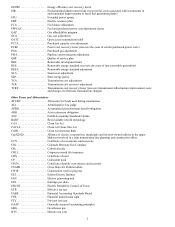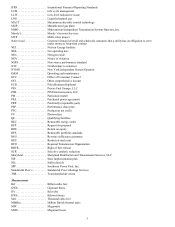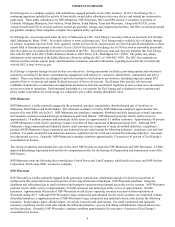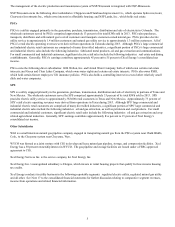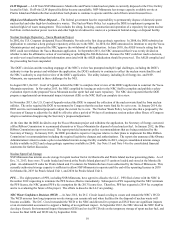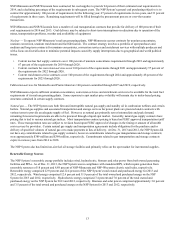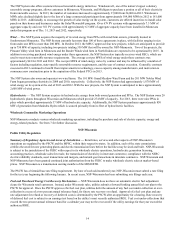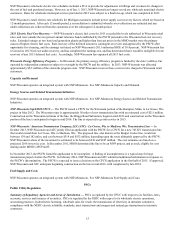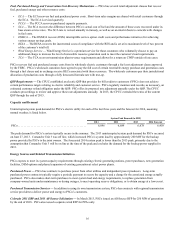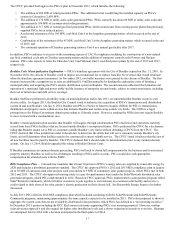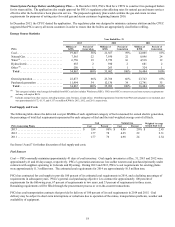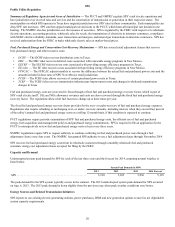Xcel Energy 2013 Annual Report Download - page 28
Download and view the complete annual report
Please find page 28 of the 2013 Xcel Energy annual report below. You can navigate through the pages in the report by either clicking on the pages listed below, or by using the keyword search tool below to find specific information within the annual report.
10
LLW Disposal — LLW from NSP-Minnesota’s Monticello and Prairie Island nuclear plants is currently disposed at the Clive facility
located in Utah. If off-site LLW disposal facilities become unavailable, NSP-Minnesota has storage capacity available on-site at
Prairie Island and Monticello that would allow both plants to continue to operate until the end of their current licensed lives.
High-Level Radioactive Waste Disposal — The federal government has the responsibility to permanently dispose of domestic spent
nuclear fuel and other high-level radioactive wastes. The Nuclear Waste Policy Act requires the DOE to implement a program for
nuclear high-level waste management. This includes the siting, licensing, construction and operation of a repository for spent nuclear
fuel from civilian nuclear power reactors and other high-level radioactive wastes at a permanent federal storage or disposal facility.
Nuclear Geologic Repository - Yucca Mountain Project
In 2002, the U.S. Congress designated Yucca Mountain, Nevada as the first deep geologic repository. In 2008, the DOE submitted an
application to construct a deep geologic repository at this site to the NRC. In 2010, the DOE announced its intention to stop the Yucca
Mountain project and requested the NRC approve the withdrawal of the application. In June 2010, the ASLB issued a ruling that the
DOE could not withdraw the Yucca Mountain application. In September 2011, the NRC announced that it was evenly divided on
whether to take the affirmative action of overturning or upholding the ASLB decision. Because the NRC could not reach a decision,
an order was issued instructing that information associated with the ASLB adjudication should be preserved. The ASLB complied and
the proceeding has been suspended.
The DOE’s decision and the resulting stoppage of the NRC’s review has prompted multiple legal challenges, including the DOE’s
authority to stop the project and withdraw the application, the DOE’s authority to continue to collect the nuclear waste fund fee and
the NRC’s authority to stop their review of the DOE’s application. The utility industry, including Xcel Energy Inc. and NSP-
Minnesota, are represented in these challenges by the NEI.
In August 2013, the D.C. Court of Appeals ordered the NRC to complete their review of the DOE’s application to construct the Yucca
Mountain repository. In November 2013, the NRC complied by issuing an order to the NRC Staff to complete and publish a safety
evaluation report on the proposed Yucca Mountain nuclear spent fuel and waste repository. The NRC also requested that the DOE
prepare a supplemental environmental impact statement (EIS) so the NRC Staff can complete its review.
In November 2013, the U.S. Court of Appeals ordered the DOE to suspend the collection of the nuclear waste fund fee from nuclear
utilities. The order required the DOE to recommend to Congress that the nuclear waste fund fee be set to zero. In January 2014, the
DOE sent its court mandated proposal to adjust the current fee to zero. The Nuclear Waste Policy Act provides that a proposal by the
Secretary of Energy to adjust the fee shall be effective after a period of 90 days of continuous session unless either House of Congress
adopts a resolution disapproving the Secretary’s proposed adjustment.
At the time that the DOE decided to stop the Yucca Mountain project and withdraw the application, the Secretary of Energy convened
a Blue Ribbon Commission to recommend alternatives to Yucca Mountain for disposal of used nuclear fuel. In January 2012, the Blue
Ribbon Commission report was issued. The report provided numerous policy recommendations that are being considered by the
Secretary of Energy. In January 2013, the DOE provided its report to Congress relative to their plans to implement the Blue Ribbon
Commission’s recommendations including the required legislative changes and authorizations. The report also announced the Obama
Administration’s intent to make a pilot consolidated interim storage facility available in 2021, a larger consolidated interim storage
facility available in 2025 and a deep geologic repository available in 2048. See Note 13 and Note 14 to the consolidated financial
statements for further discussion.
Nuclear Spent Fuel Storage
NSP-Minnesota has interim on-site storage for spent nuclear fuel at its Monticello and Prairie Island nuclear generating plants. As of
Dec. 31, 2013, there were 35 casks loaded and stored at the Prairie Island plant and 15 canisters loaded and stored at the Monticello
plant. An additional 29 casks for Prairie Island and 15 canisters for Monticello have been authorized by the State of Minnesota. This
currently authorized storage capacity is sufficient to allow NSP-Minnesota to operate until the end of the operating licenses in 2030
for Monticello, 2033 for Prairie Island Unit 1, and 2034 for Prairie Island Unit 2.
PFS — The eight partners of PFS, including NSP-Minnesota, have agreed to dissolve the LLC. PFS filed a letter with the NRC in
December 2012 requesting to terminate the PFS license effective immediately. Subsequent to PFS requesting that the NRC terminate
the PFS license, the NRC granted PFS a fee exemption for the 2013 license fees. Therefore, PFS has requested a 2014 fee exemption
and is re-evaluating the future of the project. The efforts to dissolve the LLC are pending.
NRC Waste Confidence Decision (WCD) — In June 2012, the D.C. Circuit issued a ruling to vacate and remand the NRC’s WCD.
The WCD assesses how long temporary on-site storage can remain safe and when facilities for the disposal of nuclear waste will
become available. The D.C. Circuit remanded the WCD to the NRC and directed it to prepare an EIS if there are significant impacts
or an environmental assessment to support a finding of no significant impact. In September 2012, the NRC directed the NRC Staff to
develop a Generic Environmental Impact Statement (GEIS) and revised WCD rule on the temporary storage of spent nuclear fuel, and
to issue the final GEIS and WCD rule by September 2014.




